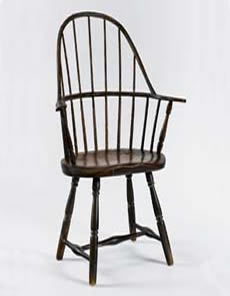 |
| Figure 37 Armchair, possibly Easton, Pennsylvania, ca. 1765. Unidentified ring-porous hardwoods and maple. H. 395/8", W. 21 5/16" (seat), D. 15 1/2" (seat); seat height: 16 1/2"; seat depth/seat width: .676; rectangular rail width: .995"; rail thickness: .744"; arm support angles: 6 and 8°. (Private collection; photo, Gavin Ashworth.) This early, simply turned chair is stronger than most comparable Philadelphia examples. The tops and bottoms of the arm supports and all of the stretcher joints are pinned, and the spindles penetrate the seat like those on the Massachusetts chair illustrated in fig. 8. The fact that few Philadelphia makers used pins to reinforce their arm supports may explain why no tall sack-backs comparable to this example are known to have been produced in that city. |